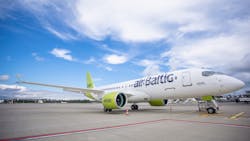airBaltic to Showcase Airbus A220 at Dubai Airshow
Latvian airline airBaltic will take part at the Dubai Airshow Nov. 14-17. Together with the aircraft manufacturer Airbus, airBaltic will showcase one of its Airbus A220-300 aircraft.
Dubai Airshow is one of the largest air shows in the world, connecting aerospace professionals across all areas of the industry to facilitate successful global trade. It will be the first global airshow since 2019 and claims to be the largest aerospace event to take place in 2021.
Since introduction of the Airbus A220-300 aircraft almost five years ago, airBaltic has carried over 6,500,000 passengers on the aircraft. Thus far, most passengers have been carried to such destinations as Amsterdam, Paris, London, and Moscow. Airbus A220-300’s have completed over 78,246 flights and flown over 175,312 block hours.
Since May 2020, airBaltic operates all its flights with a single aircraft type – Airbus A220-300, thus minimizing the complexity and benefiting from the additional efficiency provided by the aircraft.
The Airbus A220-300 has performed beyond the company’s expectations, delivering better overall performance, fuel efficiency and convenience for both passengers and the staff. This aircraft offers an excellent flying experience with such benefits for passengers as wider seats, larger windows, more hand luggage space in the cabin, improved lavatories and much more.
The Airbus A220-300 has a high-quality air filtering system equipped with High Efficiency Particulate Air (HEPA) type filter that provides the best level of filtration currently available for recirculated cabin air from the very beginning of boarding, during entire flight and until all passengers have left the aircraft. The quality of cabin air is carefully controlled and is recirculated with ventilation rates that provide a total change of air 20-30 times per hour.
In addition, the new aircraft is also considerably quieter – with a four times smaller noise footprint. Moreover, at the moment it is the greenest commercial aircraft in the world, as it is the first aircraft to have a transparent declaration of the life-cycle environmental impact, helping to reduce CO2 and NOX emissions by 20% and 50% respectively.



